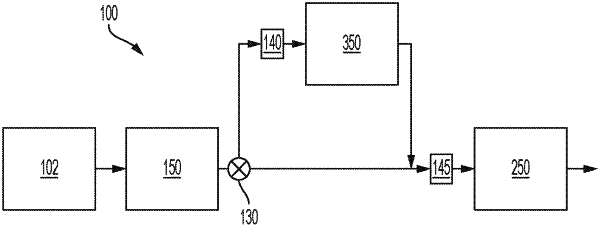| CPC F01N 3/105 (2013.01) [F01N 3/2013 (2013.01); F01N 3/2033 (2013.01); F01N 3/2046 (2013.01); F01N 3/0878 (2013.01); F01N 2240/02 (2013.01); F01N 2260/04 (2013.01); F01N 2370/04 (2013.01)] | 18 Claims |

|
1. A method for operating an internal combustion engine, the method comprising:
combusting a fuel and air mixture within a combustion chamber of an internal combustion engine, thereby forming an exhaust gas;
passing the exhaust gas out of the combustion chamber;
performing a startup procedure, the startup procedure comprising:
passing the exhaust gas from the combustion chamber to a first aftertreatment system comprising one or more catalysts;
cooling the exhaust gas from the first aftertreatment system with a first heat exchanger positioned between the first aftertreatment system and a pollutant capture unit;
passing the exhaust gas from the first aftertreatment system to the pollutant capture unit comprising one or more sorbent materials;
capturing criteria pollutants including carbon monoxide, nitrogen oxides, and unburnt hydrocarbons of the exhaust gas with the pollutant capture unit;
passing the exhaust gas from the pollutant capture unit to a second aftertreatment system comprising one or more catalysts, where the one or more catalysts in the first aftertreatment system may be the same or different from the one or more catalysts in the second aftertreatment system;
heating the exhaust gas entering the second aftertreatment system with a second heat exchanger positioned between the pollutant capture unit and the second aftertreatment system, wherein the first heat exchanger and the second heat exchanger are connected by a closed loop of a thermal transfer medium; and
heating the first aftertreatment system to a first activation temperature with the exhaust gas from the combustion chamber;
subsequent to heating the first aftertreatment system to the first activation temperature, performing a secondary procedure, the secondary procedure comprising:
passing the exhaust gas from the first aftertreatment system directly to the second aftertreatment system without passage through the pollutant capture unit; and
heating the second aftertreatment system to a second activation temperature with the exhaust gas from the first aftertreatment system; and
subsequent to heating the second aftertreatment system to the second activation temperature, performing a tertiary procedure, the tertiary procedure comprising:
splitting the exhaust gas from the first aftertreatment system into a first stream and a second stream;
passing the first stream of the exhaust gas from the first aftertreatment system through the pollutant capture unit to raise the temperature of the sorbent above a desorption temperature for a regeneration period to release the criteria pollutants captured in the pollutant capture unit; and
passing the second stream of the exhaust gas from the first aftertreatment system and the exhaust gas from the pollutant capture unit to the second aftertreatment system;
wherein, the one or more catalysts of the first aftertreatment system upon reaching the first activation temperature and the one or more catalysts of the second aftertreatment system upon reaching the second activation temperature react with criteria pollutants of the exhaust gas, thereby forming a treated exhaust gas, wherein the treated exhaust gas comprises less criteria pollutants than the exhaust gas from the combustion chamber.
|